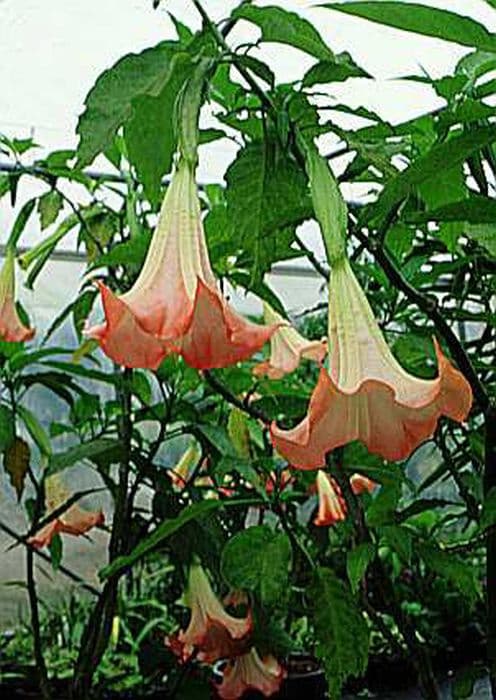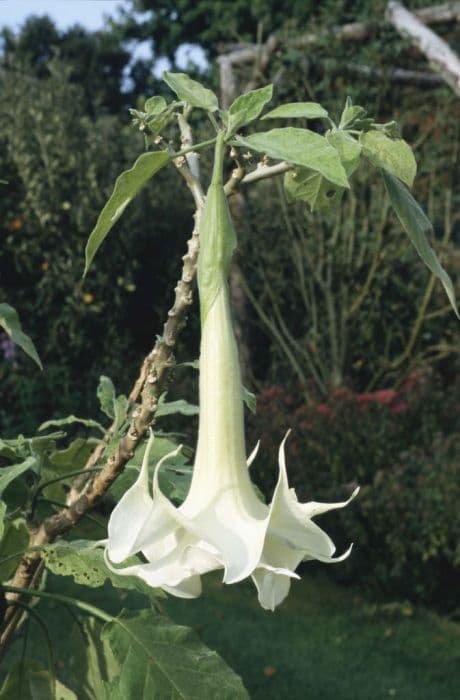Million Bells Calibrachoa Million Bells Series

ABOUT
Calibrachoa Million Bells Series is a charming plant renowned for its abundant, mini petunia-like flowers that come in a wide array of vibrant colors, including shades of pink, purple, yellow, orange, red, and blue, along with many two-toned and veined variations. The petals are delicate and trumpet-shaped with a slight flare at the edges, creating a cheerful display reminiscent of cascading bells. The foliage underneath these flamboyant blooms is a lush green, composed of small, oval leaves that form a dense and trailing habit. This plant is particularly prized for its non-stop blooming from spring to frost, providing long-lasting color in garden containers, hanging baskets, or as a ground cover. The overall impression is of a profuse, cascading burst of color, making the Million Bells an eye-catching addition to any garden display.
About this plant
 Names
NamesFamily
Solanaceae
Synonyms
Million Bells, Mini Petunia
Common names
Calibrachoa Million Bells Series
 Toxicity
ToxicityTo humans
The Million Bells plant is not known to be toxic to humans. Therefore, ingestion of this plant typically does not lead to any significant symptoms of poisoning. While it is not considered poisonous, eating any non-food plant can potentially cause mild stomach upset due to the unusual material in the digestive system, so it's always best to avoid ingesting any part of ornamental plants.
To pets
The Million Bells plant is generally considered non-toxic to pets, including cats and dogs. It does not typically cause any severe symptoms of poisoning if ingested. However, like with humans, consumption of non-food plants can sometimes result in mild gastrointestinal discomfort for pets such as vomiting or diarrhea, mainly due to the irritation caused by the plant material in the stomach. If a pet consumes a large amount, or if any adverse reactions are observed, it is still wise to contact a veterinarian.
 Characteristics
CharacteristicsLife cycle
Annuals
Foliage type
Evergreen
Color of leaves
Green
Flower color
Varies
Height
6-12 inches (15-30 cm)
Spread
12-24 inches (30-60 cm)
Plant type
Herb
Hardiness zones
9
Native area
South America
Benefits
 General Benefits
General Benefits- Continuous Blooming: The plant blooms from spring to frost, providing a long season of color.
- Low Maintenance: Requires minimal care, such as occasional deadheading to promote more blooms.
- Versatile Placement: Suitable for hanging baskets, window boxes, and containers, as well as in-ground planting.
- Attracts Pollinators: Flowers are attractive to beneficial insects like hummingbirds, butterflies, and bees.
- Wide Color Range: Comes in a variety of colors including pink, red, yellow, blue, purple, and white.
- Drought Tolerant: Once established, it can tolerate periods of low water, making it ideal for those in drier climates or looking to conserve water.
- Self-Cleaning: Most varieties do not require deadheading as they self-clean their spent blooms.
- Compact Growth: Perfect for small spaces due to its mounding and trailing growth habit.
 Medical Properties
Medical PropertiesThis plant is not used for medical purposes.
 Air-purifying Qualities
Air-purifying QualitiesThis plant is not specifically known for air purifying qualities.
 Other Uses
Other Uses- As a miniature petunia look-alike in fairy gardens, due to its small-sized flowers resembling tiny petunias, it is perfect for these whimsical miniature landscapes.
- For clothing dye, where the pigments from the flowers can be used to create natural dyes for fabric in shades of pink, purple, or blue depending on the flower color.
- In container water gardens as a floating ornament, although not a water plant, it can be set atop the water in a floating planter to add color and beauty.
- As living mulch under taller plants in mixed containers because it can spread and help retain soil moisture while adding color and texture.
- To create a colorful, living table centerpiece, by taking advantage of its trailing habit and vibrant colors, Calibrachoa can be planted in a low decorative bowl.
- For educational purposes, such as teaching genetics and selective breeding, as Calibrachoa exhibits a broad range of flower colors and patterns.
- As an artistic medium in pressed flower art, where you can press the small flowers and use them to create intricate designs due to their versatile colors and patterns.
- In ornamental edible landscapes, even though they are not edible, they provide a vibrant floral accent amongst the edible greenery.
- For attracting hummingbirds in photography, their tubular flowers are appealing to hummingbirds, making them great subjects for wildlife photographers.
- In the creation of a natural confetti for festive occasions as the small flowers, once dried, can be easily scattered and are biodegradable.
Interesting Facts
 Feng Shui
Feng ShuiThe Million Bells is not used in Feng Shui practice.
 Zodiac Sign Compitability
Zodiac Sign CompitabilityThe Million Bells is not used in astrology practice.
 Plant Symbolism
Plant Symbolism- Abundance: As the "Million Bells" name suggests, this plant is associated with vast quantities, reflecting an abundance of blessings and prosperity due to its prolific blooming.
- Gratitude: The vibrant and numerous flowers can symbolize thankfulness and appreciation, making it a great gift to express these sentiments.
- Joy and Celebration: The cheerful colors and continuously blooming nature of Million Bells evoke feelings of happiness and are often used in festive occasions.
- Perseverance: The plant's ability to bloom throughout the growing season denotes endurance and the capacity to thrive in adversity.
 Water
WaterTo adequately water a Calibrachoa Million Bells, it is crucial to maintain consistent moisture without overwatering. Monitor the plant's soil and water when the top inch feels dry to the touch, which typically means watering once every few days during active growing seasons. The actual frequency will depend on environmental conditions such as heat and humidity. A general guideline is to provide about one to two gallons per week, ensuring you water deeply enough to encourage roots to grow downward. Reduce water intake during cooler months or if the plant is not in active growth.
 Light
LightMillion Bells thrive best in full sun, which means they should receive at least six hours of direct sunlight each day. They can tolerate partial shade, but flowering may be reduced. The ideal spot for a Million Bells plant is in a location where it can enjoy unfiltered sunlight for the majority of the day, especially morning sun which is less harsh than afternoon sun.
 Temperature
TemperatureMillion Bells prefer moderate temperatures and will perform best between 55°F and 65°F. They can withstand minimum temperatures down to 40°F, but frost or freezing temperatures can damage or kill the plants. During the hottest parts of the summer, daytime temperatures above 85°F may lead to a decrease in blooming until cooler weather returns.
 Pruning
PruningMillion Bells benefit from regular pruning to encourage bushier growth and more blooms. Deadheading, or removing spent flowers, should be done routinely. A more substantial pruning to cut back leggy stems can be done mid-season to rejuvenate the plant and encourage new growth. The best time to prune is early morning or late evening to avoid stressing the plant during the heat of the day.
 Cleaning
CleaningAs needed
 Soil
SoilMillion Bells prefer well-draining soil with a mixture of peat, perlite, and compost. Aim for a soil pH between 5.5 and 6.5 for optimal growth.
 Repotting
RepottingMillion Bells should be repotted annually to replenish nutrients and prevent root-bound conditions, typically in the spring.
 Humidity & Misting
Humidity & MistingMillion Bells thrive in moderate humidity conditions, generally around 40-70%, but are quite adaptable to varying humidity levels outdoors.
 Suitable locations
Suitable locationsIndoor
Provide bright light, well-draining soil, and regular watering for indoor Million Bells.
Outdoor
Plant in full sun with well-draining soil and regular watering for outdoor Million Bells.
Hardiness zone
9-11 USDA
 Life cycle
Life cycleCalibrachoa, commonly known as Million Bells, starts its cycle with seed germination, which requires warmth and constant moisture. Upon sprouting, seedlings rapidly grow, developing a rosette of leaves. As the plant matures, it develops a bushy form, producing numerous small, petunia-like flowers throughout the growing season. Million Bells blooms from late spring to early fall, requiring full sun to maintain its prolific flowering. As an annual, after setting seeds, the plant typically dies with the onset of cold weather. Some gardeners, however, may take cuttings before frost to propagate new plants for the next season, thereby continuing the cycle.
 Propogation
PropogationPropogation time
Spring to Summer
Calibrachoa, commonly known as Million Bells, is most often propagated through tip cuttings, a method that is best carried out in late spring to early summer when the plant is actively growing. To propagate Million Bells, a gardener would typically cut a 3- to 4-inch (approximately 7.5-10 cm) length of stem just below a node, where a leaf joins the stem. This cutting should include at least two sets of leaves at the top. The lower leaves are removed, and the cut end might be dipped in rooting hormone powder to increase the chances of successful root development. The stem cutting is then inserted into a pot filled with a moistened mix of peat and perlite or a similar well-draining rooting medium. It is important to keep the medium consistently moist and provide a warm environment with indirect light for the cuttings to root, which usually takes a few weeks. Once roots have formed, the new plants can be transplanted into individual pots or a garden setting.


![Calibrachoa [Aloha Classic Blue Sky]](/_next/image?url=https%3A%2F%2Fplants-admin.emdemapps.com%2Fimages%2Fplants%2F%2Fimages%2F604b636c3778b.png&w=640&q=75)
![Calibrachoa [Aloha Classic Gold]](/_next/image?url=https%3A%2F%2Fplants-admin.emdemapps.com%2Fimages%2Fplants%2F%2Fimages%2F604b6284c573e.png&w=640&q=75)
![Calibrachoa [Aloha Classic Tiki Soft Pink]](/_next/image?url=https%3A%2F%2Fplants-admin.emdemapps.com%2Fimages%2Fplants%2F%2Fimages%2F604b548e0a5ef.png&w=640&q=75)
![Calibrachoa [Cabaret Deep Yellow]](/_next/image?url=https%3A%2F%2Fplants-admin.emdemapps.com%2Fimages%2Fplants%2F%2Fimages%2F604b5f20ca3ef.png&w=640&q=75)
![Calibrachoa [Calibasket Radiant Orange]](/_next/image?url=https%3A%2F%2Fplants-admin.emdemapps.com%2Fimages%2Fplants%2F%2Fimages%2F604b536d43cb2.png&w=640&q=75)
![Calibrachoa [Caloha Classic Blue Velvet]](/_next/image?url=https%3A%2F%2Fplants-admin.emdemapps.com%2Fimages%2Fplants%2F%2Fimages%2F604b604884a75.png&w=640&q=75)
![Calibrachoa [Caloha Classic Honey White]](/_next/image?url=https%3A%2F%2Fplants-admin.emdemapps.com%2Fimages%2Fplants%2F%2Fimages%2F604b5f56e0beb.png&w=640&q=75)
![Calibrachoa [Caloha Classic Yellow Chocolate Ring]](/_next/image?url=https%3A%2F%2Fplants-admin.emdemapps.com%2Fimages%2Fplants%2F%2Fimages%2F604b538aede95.png&w=640&q=75)